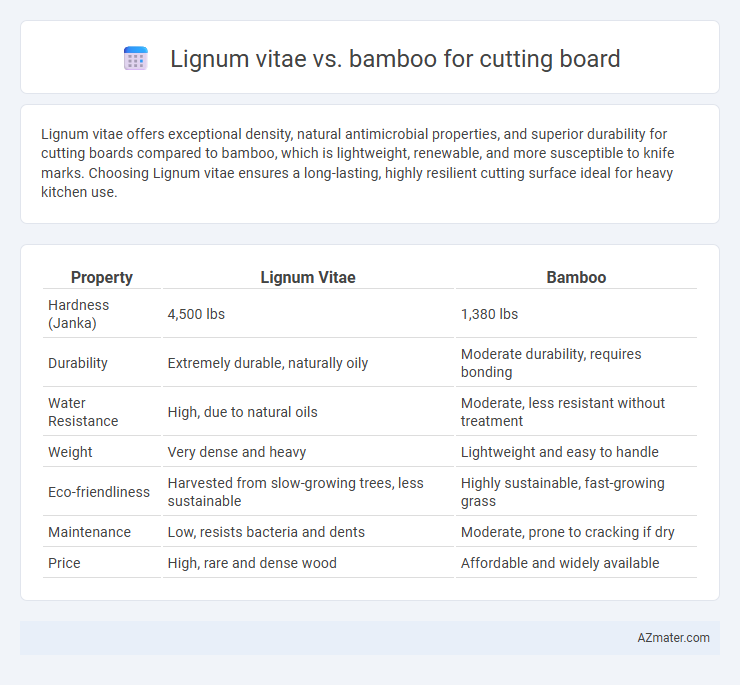Lignum vitae offers exceptional density, natural antimicrobial properties, and superior durability for cutting boards compared to bamboo, which is lightweight, renewable, and more susceptible to knife marks. Choosing Lignum vitae ensures a long-lasting, highly resilient cutting surface ideal for heavy kitchen use.
Table of Comparison
| Property | Lignum Vitae | Bamboo |
|---|---|---|
| Hardness (Janka) | 4,500 lbs | 1,380 lbs |
| Durability | Extremely durable, naturally oily | Moderate durability, requires bonding |
| Water Resistance | High, due to natural oils | Moderate, less resistant without treatment |
| Weight | Very dense and heavy | Lightweight and easy to handle |
| Eco-friendliness | Harvested from slow-growing trees, less sustainable | Highly sustainable, fast-growing grass |
| Maintenance | Low, resists bacteria and dents | Moderate, prone to cracking if dry |
| Price | High, rare and dense wood | Affordable and widely available |
Lignum Vitae vs Bamboo: Overview
Lignum vitae is an exceptionally dense hardwood known for its natural oils, high durability, and resistance to moisture, making it ideal for heavy-use cutting boards. Bamboo is a fast-growing grass that offers a lightweight, renewable, and eco-friendly alternative with good hardness but less natural moisture resistance compared to lignum vitae. While lignum vitae provides superior longevity and knife-edge retention, bamboo excels in sustainability and cost-effectiveness.
Material Hardness and Durability
Lignum vitae is renowned for its exceptional hardness, measuring around 4,500 on the Janka hardness scale, making it one of the hardest and most durable woods available for cutting boards. Bamboo, though comparatively softer with a Janka rating between 1,300 and 1,400, offers excellent durability due to its dense, fibrous structure and rapid renewability. Both materials resist wear and knife marks, but lignum vitae's superior hardness grants it unmatched longevity and resistance to dents and scratches in heavy kitchen use.
Water and Stain Resistance
Lignum vitae exhibits superior water resistance due to its dense, oily natural composition, making it highly effective at repelling moisture and preventing warping in cutting boards. Bamboo, while relatively water-resistant owing to its tight grain structure, is more prone to absorbing stains and water over time, especially if not properly sealed. The natural oils in lignum vitae provide enhanced stain resistance and durability compared to bamboo's more porous surface.
Knife Friendliness: Surface Impact
Lignum vitae is renowned for its extreme density and hardness, which provides exceptional durability but can cause faster knife dulling due to a harder surface impact. Bamboo, while still durable, offers a more forgiving surface with moderate hardness that balances cutting board longevity and knife edge preservation. Choosing bamboo reduces blade wear significantly compared to lignum vitae, making it a more knife-friendly option for frequent kitchen use.
Maintenance and Cleaning Requirements
Lignum vitae cutting boards require regular oiling with mineral or butcher block oil to maintain their natural oils and prevent drying or cracking, while bamboo boards need similar oiling but can also benefit from occasional washing with mild soap and water without soaking. Both materials resist moisture well, but lignum vitae's dense grain makes it more resistant to water absorption and bacterial growth compared to bamboo, which can be slightly more porous. Proper maintenance of lignum vitae involves avoiding prolonged water exposure, while bamboo boards must be dried thoroughly after cleaning to extend durability and sanitary use.
Eco-Friendliness and Sustainability
Lignum vitae and bamboo are both sustainable materials for cutting boards, but bamboo offers superior eco-friendliness due to its rapid growth rate and renewable harvesting cycles. Lignum vitae, a dense hardwood, grows much slower and is often sourced from endangered tree species, raising concerns about deforestation and ecological impact. Bamboo's ability to regenerate quickly without the need for replanting makes it a more environmentally responsible choice for eco-conscious consumers.
Price Comparison
Lignum vitae cutting boards typically command higher prices due to their exceptional density, durability, and natural oils, making them highly resistant to water and bacteria. Bamboo boards offer a more affordable alternative with sustainable sourcing and decent hardness, though they generally wear out faster and may require more maintenance. Price differences can range from 30% to 60%, with Lignum vitae positioned as a premium, long-lasting investment compared to budget-friendly bamboo options.
Aesthetics and Design Options
Lignum vitae cutting boards showcase a deep, rich brown color with natural streaks, offering a classic, luxurious aesthetic ideal for traditional kitchens. Bamboo cutting boards feature a light, golden hue with a uniform, striped grain pattern that complements modern and minimalist designs. Bamboo provides versatile design options including laminated layers and customizable shapes, while lignum vitae's dense, fine grain limits design variations but ensures a unique, handcrafted appearance.
Common Uses in Kitchens
Lignum vitae is favored in kitchens for its exceptional density and natural oils, making it highly resistant to knife marks and water damage, ideal for heavy-duty cutting boards. Bamboo, commonly used for eco-friendly cutting boards, offers a lightweight, sustainable option that resists bacteria growth due to its antimicrobial properties. Both materials excel for kitchen use, but lignum vitae's durability suits professional chefs, while bamboo appeals to health-conscious home cooks.
Pros and Cons Summary
Lignum vitae cutting boards offer exceptional hardness and natural antimicrobial properties, making them highly durable and resistant to knife marks, but they tend to be heavier and more expensive than bamboo. Bamboo cutting boards are lightweight, eco-friendly, and reasonably hard, providing a sustainable option that resists moisture well, though they may dull knives faster and can be prone to splitting if not properly maintained. Both materials require regular oiling to preserve their longevity and maintain food safety.

Infographic: Lignum vitae vs Bamboo for Cutting board
 azmater.com
azmater.com